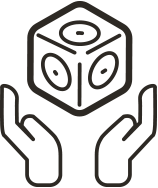The critical thinking required for effective programming and computer science is increasingly being recognized as a fundamental 21st-century skill. As experts around the world began to ask how to present concepts like decomposition, abstraction, algorithmic solutions, and debugging, one of their first steps was to make the act of coding more accessible to younger and more diverse learners.
Now, we’re used to seeing such programs as Scratch and Cubelets Blockly in elementary and middle school. These color-coded pre-built code blocks allow students to drag and drop to build a program without needing to memorize the vocabulary and syntax of a programming language first. We all agree this is more developmentally appropriate for young learners who are simultaneously still grasping the fundamentals of their primary language through reading and writing instruction.
But what about students who are pre-literate or are struggling with reading in their native language? That’s where Cubelets come in. Cubelets are block-based programming. Literally. Each Cubelet is itself a color-coded block of programming. We also refer to this as Tactile Coding, since Cubelets program robot behaviors without a screen. For example, the Inverse Cubelet is equivalent to an inverse block in Cubelets Blockly.

When students combine Cubelets in different arrangements, they are physically creating different programs that include different commands in different orders. Take a look at this:



This means Cubelets are a great way to introduce computer science without adding any additional screen time to your lessons. Every time students build with Cubelets, they are practicing computational thinking and preparing to build code using block-based languages.
Then, we scaffold students from Tactile Coding into Personality Swaps to help them understand how software affects robot behavior and then we introduce them to screen-based Cubelets Blockly. Did you know you can load the Blockly code for all of our Personality Swaps directly in Cubelets Blockly?
Some of our Cubelets sets are better curated for Tactile Coding, while others accelerate you into the Cubelets coding environments more quickly. For instance, the Curiosity Set is designed to build steering robots that solve all sorts of different problems, which gives young designers more choices while improving their design. In contrast, the Cubelets Discovery Set includes just the fundamental Cubelets as well as a Bluetooth Hat, so creating a steering robot requires either the Cubelets App or Cubelets Blockly.
Don’t worry, though, all of our Education Packs are designed to first foster Tactile Coding with students of all ages before introducing them to screen-based coding alternatives. Cubelets give students concrete, three-dimensional models to use as they begin to conceptualize networked computing systems and how complex systems work. These intuitions set the stage for a deeper understanding of the fundamental structures of programming, regardless of coding language.
Enjoyed this blog post? Sign up for the #CubeletsChat newsletter to receive the next blog post straight to your inbox. Plus join the discussion on twitter using the #CubeletsChat hashtag!


